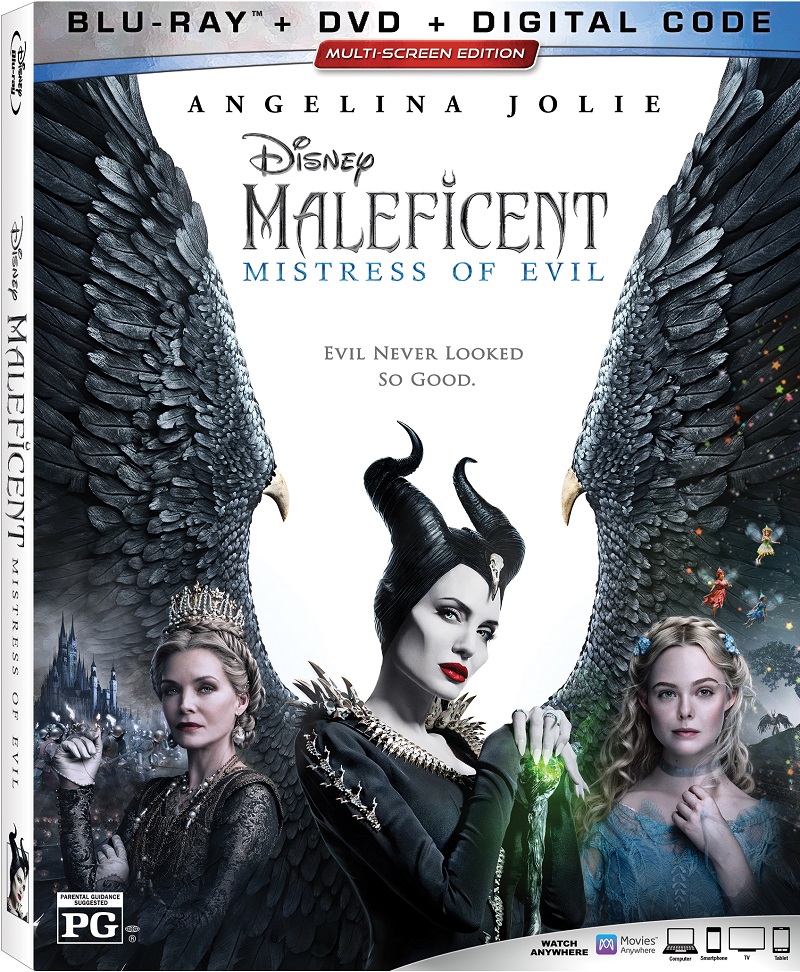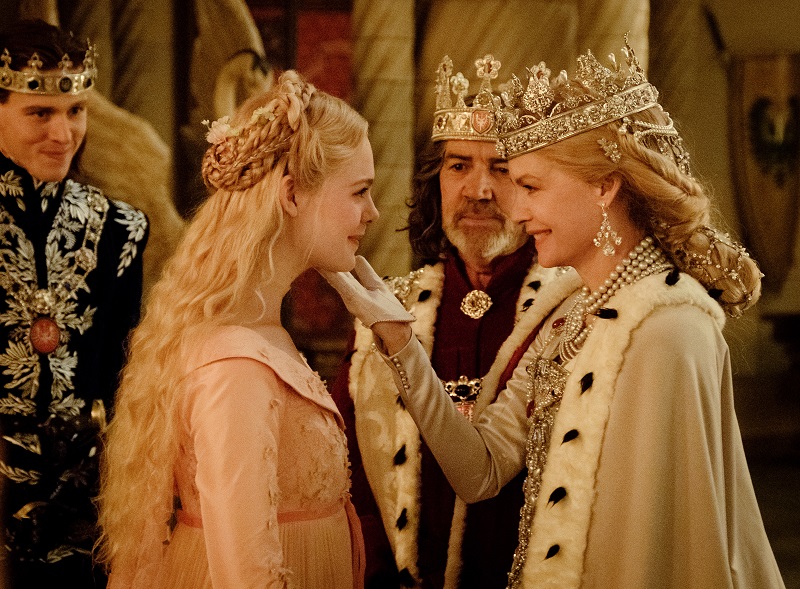Six years ago, Disney did something extraordinary that speaks volumes to the immense creative power they’re extolling of late. It was 2014 and Angelina Jolie and her cinematic alter ego, Maleficent, were on their way into theaters in a live action storytelling of the iconic Mouse House villain. Jolie’s latest addition to her character resume is one that frequently lands on many film journalists’ lists of the evilest villains in Hollywood history. What is so extraordinary is Disney built a live action movie around a villainous soul whose mere image strikes fear in the hearts of millions of grown-ups who as children were traumatized by her in Sleeping Beauty …and it was a blockbuster, banking almost $760 million globally.

Now, the sequel Maleficent: Mistress of Evil is out on DVD, Blu-Ray and digital download formats.
What made the first film work so well was Linda Woolverton’s script (based on Charles Perrault’s book, La Belle au bois dormant) had humanized the evil doer by delving deep into the psychology of Maleficent, tapping those innate maternal streaks. Instead of cursing the young royal in that legendary way (watch out for that pin prick!), by the close of the Maleficent, Jolie’s character had essentially adopted the “not-so-sleepy anymore” beauty, Aurora (Elle Fanning). The Robert Stromberg directed film popped off the screen with a color palette that was truly majestic. It possessed action sequences featuring the titular character flexing her wings and a varied human and creature ensemble richly anchored in storytelling lore that goes back centuries.
Much of the credit for the film’s success certainly lay at the titanic talent of Jolie and Fanning, and most importantly—their “mother-daughter” chemistry that actually warmed the heart. Yes, we’re talking about one of the more awful cinematic individuals (live action or animated) in history.
In Maleficent: Mistress of Evil, there is reason to be joyous. There has been peace between the two kingdoms of the Moors—a magical forest realm—and Ulstead. The former is being ruled by Queen Aurora as anointed by its previous “ruler,” the title character. The latter, where Prince Phillip (Harris Dickinson) hails, is currently governed by his father, King John (Robert Lindsay). As is done in sequels, we get to meet a new character who was nowhere on the horizon in the first film, King John’s wife, Queen Ingrith (Michelle Pfeiffer).
Soon after our story starts, Prince Phillip proposes to Queen Aurora. She says yes and ladies and gentlemen, we’re going to have ourselves a royal wedding! Problem is, Maleficent is not so sure about this union and what it means to her. She’s toned down her evil ways to raise this girl in the most innocent of manners, yet there is something about this proposal that has her seeing green. Somehow, she pulls it together and even agrees to meet the parents over dinner.
Screenwriters Micah Fitzerman-Blue, Noah Harpster and Woolverton have crafted a classic scene here and it intelligently sets everything in motion. As the dinner commences, small talk ensues. Then, Pfeiffer’s Queen Ingrith wastes no time asking questions of Aurora and Maleficent that reek of invasiveness and provocation. That iconic green hue that represents the Sleeping Beauty villains’ power coming to life bursts out from all corners of this dining hall, effectively ending the dinner before one bite of food has been eaten.
Maleficent: Mistress of Evil is a thrilling opportunity to witness an Oscar winner (Jolie) and a three-time nominee (Pfeiffer) go at it in a “I love Aurora more than you” battle. Caught in the middle is Aurora, whose disgust of both exponentially explodes over the course of the film.
Pfeiffer has a blast. It’s devilishly delightful to see her play such a character. Jolie, meanwhile, has even more to chew on with her character’s spot in the sequel. Jolie portrays her as a layered, complicated soul whose tendencies for evil are the first thought and action. There are countless folks out there who have anger issues. I’m not saying this fictional iconic villain can’t control her anger, but … the proof is in the proverbial pudding.

Fanning is a stunner on so many levels. The vastness of her talent knows no bounds. She nailed it as a royal of this fantastical realm as powerfully as she intrinsically commanded our attention earlier this year as an aspiring singer in Teen Spirit belting out Robyn’s smash hit Dancing on My Own. She is steadily garnering a resume that gives the impression that she is just scratching the surface of her potential.
As teased in the Maleficent: Mistress of Evil trailer, viewers learn that there are others like Maleficent. They have lived in hiding in fear from the humans. Their arrival on the scene further expands this world (something sequels should aspire to do) and they intricately play a role in the ensuing conflict. It is stunningly epic how director Joachim Rønning (Kon-Tiki)—who took over for Stromberg—has orchestrated the battle sequences whose scope could not feel more expansive. The new helmer also has a firm command on these characters and one could argue audiences even get a deeper sense of who Maleficent is and why she does what she does with the introduction of others like her.
Taken as a two-hour whole, there are elements that could have been cut. There are a handful of what I like to call mind wandering opportunities but prepare to be impressed by the rare sequel that matches the original and dare I say, even improves on it a bit.
The Maleficent: Mistress of Evil bonus features take viewers behind-the-scenes with the all-star ensemble. Also fascinating are how the filmmakers remove the curtain on their “Oz” and showcase the visual effects behind the film’s stunning landscapes.
Since the film does a stellar job of expanding the world of those like Maleficent, dive into the featurette Origins of the Fey for a nice look at how filmmakers chose the iconic character’s origins and this species that shows she is not alone.

If You Had Wings explores how Dark Fey’s wings define and support the character in matters that are literal and figurative. They are keenly a part of the emotional DNA and, of course, are integral to flight. This featurette also informs how the visual effects team utilized EFX to have the Fey soar. Maleficent: Mistress of Evil VFX Reel is like a greatest hits package of post-visual effects shots with those involved in making the flick’s adding insight with rich comments.
One of the scenes that Fanning was most excited about, and it showed (!) was her character’s big day. Aurora’s Wedding is a (sadly) too quick (it’s still awesome, though!) exploration of the fairy tale wedding scene and how it was all put together—from the dress, the music, costuming the guests and in a stroke of pure joy, filmmakers included some video that feel like those 80s-style camcorder-recorded well wishes.
There are two Extended Scenes as part of the extras that are must-sees. They are The Queen Comforts Aurora and Philip and Aurora Dance. The first finds Queen Ingrith playing Aurora as she is in a not-so-stellar state of mind and somehow getting the princess to fast-track those wedding plans. The second should be a lovely moment, but instead has Aurora having trouble getting Queen Ingrith’s approval as it serves as an awakening for the young lady who now knows how the rest of the aristocracy sees her.
Lastly, there’s a nice Outtakes featurette that is quite funny and a music video included for Bebe Rexha’s You Can’t Stop the Girl—an impeccable moniker for a song from this flick!
Film Grade: B
Bonus Features: B

